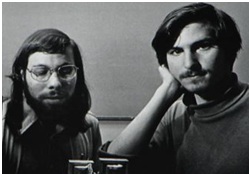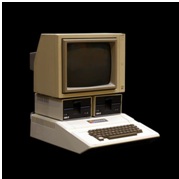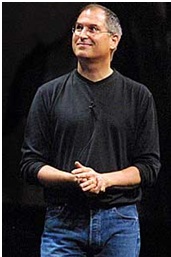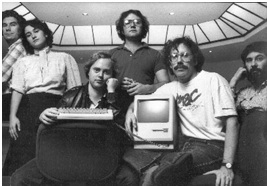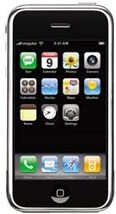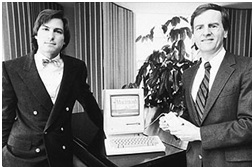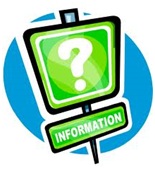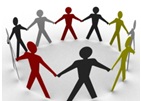|
 |
|
 |
Apple - Innovation, Design and Customer Satisfaction
Apple
Key people
Co-founder and chief executive (pictured right) from 1997 until six weeks before his death from cancer in 2011. He was fired by Apple in 1985 and then set up
Tim Cook Chief executive since 2011
Jonathan Ive Head of design. The British designer responsible for making Apple’s products beautiful as well as functional.
Steve Wozniak Co-founder and computer engineer who created two early personal computers at the
Californian home of Jobs’ parents:
Wozniak and Jobs are pictured right together in 1976.
Key competitors All Apple’s products have tough competition: iPhone - Blackberry, HTC One, Samsung Galaxy, Sony Xperia and Nokia E72. iPod - other MP3 Player manufacturers like Sony and Samsung. iTunes - Amazon MP3, Spotify and 7digital. iMac - all the leading PC makers e.g. Dell and Hewlett-Packard (also owner of Compaq). iPad - Amazon Kindle Fire, Samsung Galaxy Note, Microsoft Surface and Toshiba Encore.
Key quotes on innovation (by Steve Jobs) Don’t be trapped by dogma which is the result of other people’s thinking. Out of curiosity comes everything. The people that really create the things that change this industry are both the thinker and doer in one person. Innovation has nothing to do with how many R&D dollars you have...It’s about the people you have, how you’re led, and how much you get it. We have always been shameless about stealing great ideas. A lot of times, people don't know what they want until you show it to them. The only way to do great work is to love what you do.
Introduction – Apple and innovation Founded on April 1st 1976 by Steve Jobs, Steve Wozniak and Ronald Wayne (who left 11 days later), Apple was voted the world’s best company in 2014 by Fortune magazine. In 2015 Apple had the biggest quarterly profits in history ($18 billion).
This phenomenal success has resulted from its incredible innovation: • Apple I (1976) and Apple II (1977, pictured right) – early pioneering personal computers. • Macintosh personal computer (1984) – commonly called a Mac (renowned for being virus free and user friendly). • PowerBook (1991) – a portable PC and forerunner of today’s laptop computer. • iMac (1998) – a PC famous for its translucent coloured plastic exterior. • iTunes (9th January 2001) – music software (initially only available on Mac computers). • Apple Stores (19th May 2001) – first two stores open. • iPod (10th November 2001) – the portable digital music player linked to iTunes. • iPhone (2007) – an instant hit. • MacBook Air (2008) – the world’s thinnest notebook computer. • iPad (2010) – the hugely successful tablet (mobile) computer.
Why Apple is so good at innovation 1. Leadership - Jobs and Cook Even after his death, Steve Jobs still has a big effect on Apple’s success. He had a vision (based on technically brilliant, beautiful products to change the world) and put it into action through his:
He is responsible for one of Apple’s greatest strengths
The new boss, Tim Cook (pictured right), is:
His strength is operational efficiency, and he has done well to continue Apple's fantastic innovation record with new products like the:
2. Corporate culture The legacy of Jobs’ toughness is reflected in Apple’s shared values and beliefs (or corporate culture):
a) accountability for performance (particularly achieving customer delight through constant innovation). b) quick (anti-bureaucratic) decision making
c) long-term planning Tim Cook has a weekly strategy meeting with his top executives Every year the ‘Top 100’ (Apple’s 100 most influential people, irrespective of position, chosen by Cook) meet to discuss strategy at a secret location.
Apple is brilliant at putting these values into action. Constant innovation is a way of life.
3. Simplicity Apple always chooses the simplest way of doing something. So its structure is simple, based on functions, not divisions, making it easier to create multi-functional teams to develop new products. Communications are always clear and straightforward Everyone reports to Cook via his top executives, each responsible for a key activity like:
4. Empowerment, action and money Empowerment (taking responsibility for results) is vital to the effectiveness of the multi-functional teams which develop Apple’s new products. Everyone:
The team that developed the Macintosh computer is pictured right below in the early 1980's.
Apple:
a) uses the best suppliers For example, it hired the London Symphony Orchestra for its iMovie software.
b) has brilliant research and development Apple spends millions on research and development (R&D) but much more effectively than its competitors Its R&D expenditure as a percentage of sales revenue is less than half the industry average and a fifth of what Microsoft spends . c) focuses on great products Money is spent wisely on a few new products (like the iPhone pictured right), but no expense is spared to get them absolutely right.
5. Customer delight Apple is product oriented – in other words, it
“We think about creating new innovative products that will surprise and delight our customers”, Steve Jobs said. Apple doesn’t use market research to ask what customers want, because they don’t yet know about the new revolutionary products that Apple is developing. “You can’t ask what they want, if it’s around the next corner”, Jobs commented. This marketing strategy (supported by its famous logo) has given Apple:
6. Learning and continuous improvement Apple is constantly learning from its mistakes and failures:
Jobs was reminded that technical innovation can’t ignore customer requirements by the then chief executive, John Sculley, who forced him to resign in 1985 (pictured right together in that year). Jobs then created another computer company, Next, which taught him that customers won’t buy computers that are too expensive. Apple is so successful, because (driven by incredibly high standards) it improves its hardware and software more often than its competitors. He told the iPod team that the first prototype was too big and dropped it in a fish tank, so that the escaping bubbles would prove him right! But they enthusiastically came up with a much better alternative.
7. Creative destruction People at Apple are constantly challenging existing knowledge to find new and better solutions to customers’ problems. Jobs always encouraged a creative environment that was:
In 1983 he told his team of Macintosh computer engineers: “It’s better to be a pirate than join the navy” In other words, a creative rebel is better than a conformist imitator. This philosophy is still alive today.
8. Brilliant people Apple is full of people with the attributes of success:
Their commitment to Apple and its products is total. “They have to be really smart. But the real issue for me is, are they going to fall in love with Apple?”, Steve Jobs said about his new recruits. So he always asked them at interview: “Why are you here?” 9. Great design Jobs has always recognized that beautiful design gives Apple an edge over its competitors. One of his best decisions was to recruit the Briton, Jonathan Ive (pictured right) as the head of his design team. Ive has brilliantly combined the two essentials of great design
Ive says that the reasons for Apple’s design success are:
a) inventive curiosity Always looking for new and better designs and materials to work with. b) teamwork Ive’s design team works effectively together in an informal atmosphere with music blaring!.
c) cross-functional co-operation The design team works closely with:
d) fanatical attention to detail
e) challenging goals Apple and Ive have never shied away from aiming for great designs, when it would have been easy to be content with lower (but satisfactory) standards. Ive has said: “Some of the bravest things we’ve done are really at that point when you say, That’s good, and it’s competent, but it’s not great”.
A big thank you to... Adam Lashinsky’s two great Fortune magazine articles on Apple:
Walter Isaacson , Steve Jobs (2011) - a wonderful biography. |
|
|
||
|
|
|
||
|
||
| Copyright © wisdomtowin.com All Rights Reserved | ||
|


